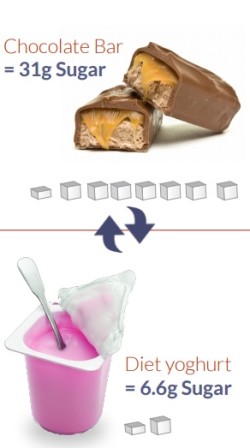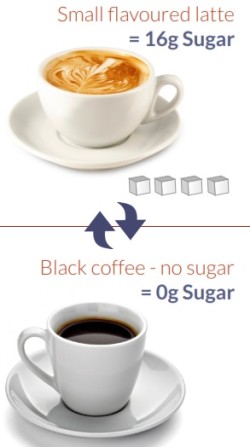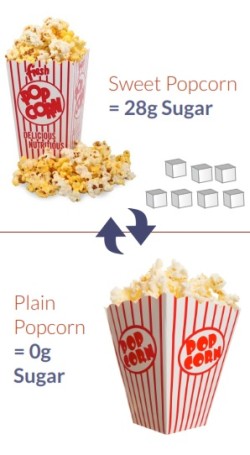Our intakes of sugar have increased dramatically over the last 10 years. Fizzy drinks and sweet foods are the obvious culprits, but many people are not aware of other foods which also contain large amounts of free sugars.
Free sugars have been classified as simple sugars added to foods by the manufacturer or consumer. Free sugars also includes sugars that are naturally in honey, syrups and fruit juices.
The WHO (World Health organisation) recently published guidelines on sugar intake for adults and children saying that no more than 10% of a person’s energy intake (calories) should come from free sugars. In Ireland, the National Adult Nutritional Survey in 2011 showed that on average our diets contained 14.6% energy from free sugars.
High intakes of this type of sugar need to be addressed because it is associated with:
• Poor dietary quality
• Tooth decay
• Obesity
It also increases the risk of preventable diseases like:
• Coronary heart disease (CHD)
• Type 2 diabetes
An average adult requires 1,500-2,000 calories per day. If 10% of this was to come from free sugars, this would equal 10-14 teaspoons of sugar per day.
A teaspoon of sugar is approximately 4g, or one sugar cube.
How can we become sugar smart?
Understanding food labels is a great tool in becoming sugar smart. Added sugars can come under many different names like:
• Glucose
• Sucrose
• Maltose
• Corn syrup
• Honey
• Invert sugar
• Hydrolysed starch
• Fructose
The higher up on the ingredients list any of these sugars is then the more it contains in the products. Look for the carbohydrate on the label, and the words ‘of which sugars’. That will tell you how much sugar the item contains per 100g.
• More than 15g per 100g is considered high
• Less than 5g per 100g is considered low
For more information on food labels see our Understanding Food Labels Guide
Meeting for coffee
Meeting friends and family in a local coffee shop for a cup of coffee and often a sweet treat too has become the norm. Coffe shops are found all over and have an abundance of baked goods, sweet treats, and beverages to choose from. But, buyers beware – many of the available choices are laden with free sugars.
For example:
• A muffin could contain the equivalent of 8 teaspoons of free sugars
• A slice of cake, 14 teaspoons
• A large hot chocolate with marshmallows and whipped cream – a whopping 18 teaspoons of free sugars
Making small changes like choosing small serving sizes and unsweetened coffees or sharing your usual scone or tea cake with a friend can all help reduce your free sugar intake.
A typical night at the cinema often involves popcorn, sweets or other goodies along with the latest blockbuster.
Did you know that a ‘combo’ meal of medium sweet popcorn, a sharing size bag of sweets and a regular fizzy drink could contain 47 teaspoons of free sugars. Incredible isn’t it?!
Here are some ways to reduce your sugar intake at the cinema.
• Choose water or a diet drink
• Opt for plain or unsweetened popcorn
• If choosing ice-cream, ask for a single scoop of a flavour you really enjoy, or go for a small portion of frozen yoghurt, avoid the sauces and toppings
• Try to avoid the Pick & Mix sweet counter
Did you know that a sharing-size packet of wine gums, chocolate minstrels or M&Ms will contain approximately 27 teaspoons of sugar? Share the item with friends to reduce the portion or avoid altogether.
Just like the cinema, movie nights at home can be a significant source of free sugars. Supermarkets and DVD rental outlets offer value deals for sweet treats. The snacks seem to have somehow become a central part of the modern movie night experience. The advantage of home movie nights though is the control you have over your snack choices.
Healthy snacks at home
- Make your own popcorn, you can control what you add. Keep it plain for the healthiest option
- Avoid the sugary fizzy drinks – instead serve chilled jugs of water flavoured with wedges of tangy lemon and oranges. Be creative with vegetable crudités and dips such as tomato salsa and hummus, far healthier than nachos
- Create a fruit platter with wedges of melon, grapes and sliced kiwi and strawberries to give a sweet treat without added sugars
 Tackle your supermarket trolley
Tackle your supermarket trolley
- To reduce the risk of sugar-laden impulse buys, be sure never to shop when hungry
- Plan your shopping based on what you’ll need for meals during the week (don’t forget snacks and packed lunches)
- Always write a shopping list. Having a shopping list to hand will help keep your focus during the grocery shopping!
- Take some time at home to have a look at the food labels of foods usually on your list. If you find that the sugar content is high for some foods, why not consider swapping for lower sugar options. Replace fizzy drinks with diet varieties, or ‘no added sugar’ cordial
- Keep sweet treats as occasional purchases and replace crisps with plain popcorn
- What about choosing porridge as a cereal; rice cakes instead of cereal bars; and making sauces from scratch?
For more information on how to get shop sugar smart, take a look at our Supermarket Shopping Guide. Click here to check out our recipe book for healthy recipe ideas.
Remember
Including small amounts of free sugars in your diet does no harm, but remember they should only be included as occasional treats rather than every day foods or drinks. The more fresh foods and drinks you include in your diet, the less room there will be for free sugars.
Small changes matter – making a few changes to the way you eat and drink can make a big difference to your health over time.
See www.diabetes.ie/sugar-smart for more information on free sugars and how they can affect your health.
Click here to take the ‘sugarsmart’ quiz to see how your intake compares to the recommendations.







